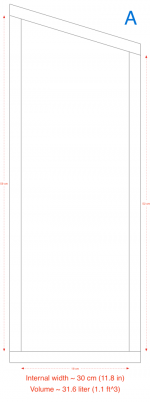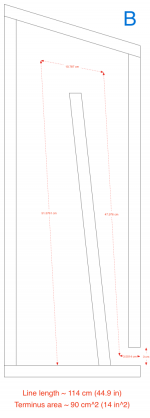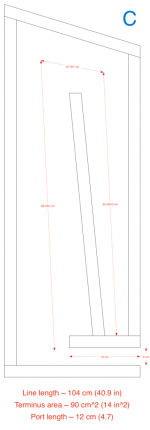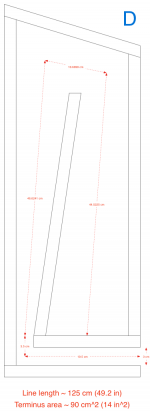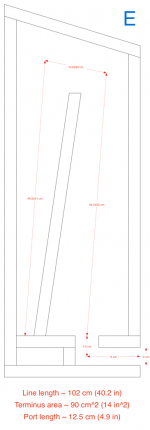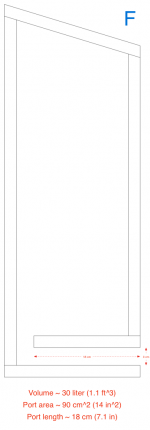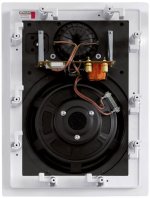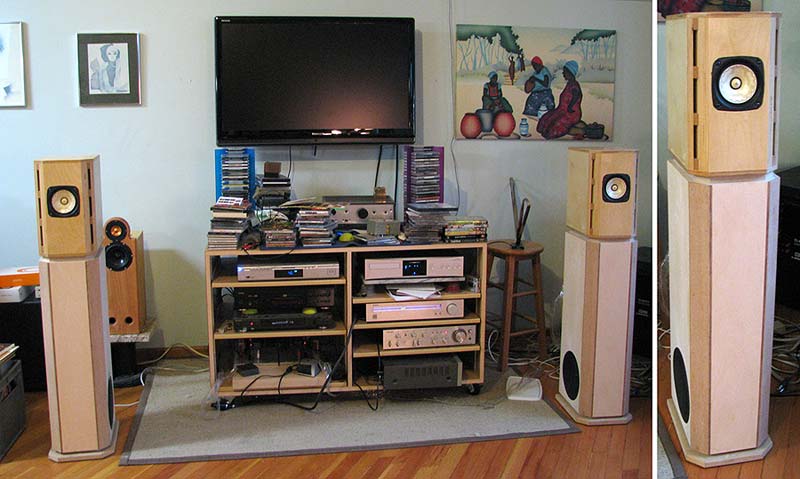Hi everyone. I have been into vintage hifi for a while, currently running a pair of B.I.C SoundSpan TPR-600 that I got in mint condition from a friend. I personally love the look of these speakers but my wife claim that they “take over the room”. Her wish list is for something small that “blend with the walls” (white by the way).
Our house is an open floor plan acoustic nightmare where the omnidirectional qualities of the SoundSpan really shines. I was therefor thinking about swapping them for something like a pair of white Sonab OA-5 (type II). It was while surfing for alternatives I stumbled across the Silent Speaker II by Direct Acoustics (reviewed here and here). This speaker really intrigues me. I really like the look of it but I would need it in white so I started to play with the idea of building something like it myself. Building them will be no problems but I doubt I got the skills to reverse engineer them or designing something close to it. That's why I am asking for your help and feedback.
I have gathered as much information as possible about the Silent Speaker, here's a summery:
Frequency Response
40Hz to 10,000 Hz ± 2 dB
30 Hz to 17,000 Hz ± 4 dB
20 Hz to 20,000 Hz ± 6 dB
Dimensions
13½” wide (34.29 cm); 9” deep (22.86 cm); 22” at front (55.88 cm), 25” at rear (63.50 cm)
Power Maximum: 50 watts continuous
Power Recommended: 200 watts recommended for handling transients
Rated Impedance: 6 ohms
Minimum Impedance: 4 ohms
Crossover
The woofer is designed mechanically and electrically to roll off naturally, no additional filtering is necessary from the crossover. A two pole network adds to the natural rolloff of the tweeter, additional components equalize the tweeter response to achieve maximum flatness in the prescribed room location.
Frequency: 1600Hz,
Woofer Slope: 24 db/octave
Tweeter Slope: 24bd/octave
Driver Complement
Woofer: 6.5” with ±¼” linear travel
Tweeter: 1” soft dome type with magnetic cooling fluid
Bass Enhancement
The complex internal cabinet chambers extract the bass frequencies from the low frequency driver and feed them out through a slot in the bottom of the cabinet.
Woofer
For deep bass, the woofer is designed with a long voice coil and a soft suspension. It is relatively small in diameter, in order to provide good dispersion at the crossover frequency to the tweeter.
Tweeter
The tweeter is of the soft dome style. It uses a European design and includes magnetic cooling fluid for the voice coil.
That was all from the manufacturer, the following I got from one of the reviews:
Given this information I started my guesswork about the design of “the complex internal cabinet chambers”.
Attached are six different drawings I did to visualize what the Silent Speaker might look like internally:
A. This picture is just the cabinet itself to get a feel for the overall volume. I got it to just above 30 liters.
B. This picture plays with the idea of a tapped and folded inverted horn. I have never seen a tapped horn where the speaker has been mounted on the top like this but I guess it would work. The line seems quite short and the terminus quite slim but I don't know much about T-Lines or Horns.
C. I started to play with the idea of a MLTL while reading up on T-Lines and Horns. Picture C is my initial response. I guess it could pass as a MLTL but its not an inverted horn and I don't know if the design makes sense.
D. This is an attempt to bring it back to an inverted horn again. Would this qualify as an MLTL? I guess not but it looks quite cool and the line is longer than before.
E. This is another take on the MLTL but I don't know if its better or worse than C.
F. This is me giving up on Horns, T-Lines, MLTL etc and throwing together a ported enclosure in the shape of the Silent Speaker.
Now to my questions:
Looking forward to your feedback / Rob
Ps. I am willing to play a bit with dimensions etc as long as the look and function of the original is somewhat maintained.
Our house is an open floor plan acoustic nightmare where the omnidirectional qualities of the SoundSpan really shines. I was therefor thinking about swapping them for something like a pair of white Sonab OA-5 (type II). It was while surfing for alternatives I stumbled across the Silent Speaker II by Direct Acoustics (reviewed here and here). This speaker really intrigues me. I really like the look of it but I would need it in white so I started to play with the idea of building something like it myself. Building them will be no problems but I doubt I got the skills to reverse engineer them or designing something close to it. That's why I am asking for your help and feedback.
I have gathered as much information as possible about the Silent Speaker, here's a summery:
Frequency Response
40Hz to 10,000 Hz ± 2 dB
30 Hz to 17,000 Hz ± 4 dB
20 Hz to 20,000 Hz ± 6 dB
Dimensions
13½” wide (34.29 cm); 9” deep (22.86 cm); 22” at front (55.88 cm), 25” at rear (63.50 cm)
Power Maximum: 50 watts continuous
Power Recommended: 200 watts recommended for handling transients
Rated Impedance: 6 ohms
Minimum Impedance: 4 ohms
Crossover
The woofer is designed mechanically and electrically to roll off naturally, no additional filtering is necessary from the crossover. A two pole network adds to the natural rolloff of the tweeter, additional components equalize the tweeter response to achieve maximum flatness in the prescribed room location.
Frequency: 1600Hz,
Woofer Slope: 24 db/octave
Tweeter Slope: 24bd/octave
Driver Complement
Woofer: 6.5” with ±¼” linear travel
Tweeter: 1” soft dome type with magnetic cooling fluid
Bass Enhancement
The complex internal cabinet chambers extract the bass frequencies from the low frequency driver and feed them out through a slot in the bottom of the cabinet.
Woofer
For deep bass, the woofer is designed with a long voice coil and a soft suspension. It is relatively small in diameter, in order to provide good dispersion at the crossover frequency to the tweeter.
Tweeter
The tweeter is of the soft dome style. It uses a European design and includes magnetic cooling fluid for the voice coil.
That was all from the manufacturer, the following I got from one of the reviews:
I measured the slot (pixel counting from pictures) to be roughly 32 x 3 cm. It equals an Effective Piston Area of ~ 96 cm2, a circular port diameter of ~ 11 cm.The SS2s use a bass slot (that runs along the bottom of the front of each speaker) that’s coupled to the the woofer through an inverted horn configuration.
Given this information I started my guesswork about the design of “the complex internal cabinet chambers”.
Attached are six different drawings I did to visualize what the Silent Speaker might look like internally:
A. This picture is just the cabinet itself to get a feel for the overall volume. I got it to just above 30 liters.
B. This picture plays with the idea of a tapped and folded inverted horn. I have never seen a tapped horn where the speaker has been mounted on the top like this but I guess it would work. The line seems quite short and the terminus quite slim but I don't know much about T-Lines or Horns.
C. I started to play with the idea of a MLTL while reading up on T-Lines and Horns. Picture C is my initial response. I guess it could pass as a MLTL but its not an inverted horn and I don't know if the design makes sense.
D. This is an attempt to bring it back to an inverted horn again. Would this qualify as an MLTL? I guess not but it looks quite cool and the line is longer than before.
E. This is another take on the MLTL but I don't know if its better or worse than C.
F. This is me giving up on Horns, T-Lines, MLTL etc and throwing together a ported enclosure in the shape of the Silent Speaker.
Now to my questions:
- Any thoughts about B-E or what are your guesses about the internal design of the Silent Speaker?
- Any suggestions for speaker elements based on the original ones, B-E or your own design?
- If I give up on exotic ideas and opt for F, any suggestions for speaker elements, tuning and cross frequency based on a 2-way, slot ported 30 liters enclosure?
Looking forward to your feedback / Rob
Ps. I am willing to play a bit with dimensions etc as long as the look and function of the original is somewhat maintained.
Attachments
Last edited:
Another question about MLTL in general...
I don't know much about MLTL in general and I have never built a Horn, T-Line or MLTL before. I read up on classic T-Line and thought that the 1/4 wave and the length on the line was crucial. I ended up with a length around 2 meters for ~ 40Hz. It seems like the Silent Speaker might have a line length of only 1-1.25 meter (40-50 inch) and that seems way to short (if it got a line at all there is).
But the The Invictus MLTL for example claims to be a MLTL and it seems to be only 42 inch in length (as I see it). What am I missing here?
I don't know much about MLTL in general and I have never built a Horn, T-Line or MLTL before. I read up on classic T-Line and thought that the 1/4 wave and the length on the line was crucial. I ended up with a length around 2 meters for ~ 40Hz. It seems like the Silent Speaker might have a line length of only 1-1.25 meter (40-50 inch) and that seems way to short (if it got a line at all there is).
But the The Invictus MLTL for example claims to be a MLTL and it seems to be only 42 inch in length (as I see it). What am I missing here?
Last edited:
Hi,
Not the sort of thing you can work out on paper or in normal
simulators. E.g. different bassmids will have different optimum
baffle angles and some of them will be entirely unsuitable.
The point of a MLTL is the length does not determine tuning.
Probably simpler and more sensible to simply go vented.
Noting the taller you make the speaker the worse it will be,
as you ears will be more off axis the higher the cabinet top.
Its a difficult ask, but I'd recommend this tweeter :
https://www.intertechnik.de/Shop/Lo...ige/Seas-Tweeter/_KT27G550_1768,en,4842,48646
Due to its excellent of axis performance and probably this :
https://www.intertechnik.com/Shop/L...tige/Seas-Woofer/_P18RNXP_1768,en,3630,115048
Due to its excellently smooth upper range rolloff.
Good luck, its a big ask. Up against a wall and not too tall, you may be able
to get away with a 1st order series x/o @ 3KHz + L-pad on the tweeter. *
I'd suggest about 30 degrees above horizontal for the baffle angle.
rgds, sreten.
* Pure guesswork on my part, don't hold me to it at all.
Not the sort of thing you can work out on paper or in normal
simulators. E.g. different bassmids will have different optimum
baffle angles and some of them will be entirely unsuitable.
The point of a MLTL is the length does not determine tuning.
Probably simpler and more sensible to simply go vented.
Noting the taller you make the speaker the worse it will be,
as you ears will be more off axis the higher the cabinet top.
Its a difficult ask, but I'd recommend this tweeter :
https://www.intertechnik.de/Shop/Lo...ige/Seas-Tweeter/_KT27G550_1768,en,4842,48646
Due to its excellent of axis performance and probably this :
https://www.intertechnik.com/Shop/L...tige/Seas-Woofer/_P18RNXP_1768,en,3630,115048
Due to its excellently smooth upper range rolloff.
Good luck, its a big ask. Up against a wall and not too tall, you may be able
to get away with a 1st order series x/o @ 3KHz + L-pad on the tweeter. *
I'd suggest about 30 degrees above horizontal for the baffle angle.
rgds, sreten.
* Pure guesswork on my part, don't hold me to it at all.
Last edited:
I know and that's why I had to call for help. Thanks for taking the time, I will go through your answer and see if I can come up with something.Good luck, its a big ask.
I totally understand and promise not to hold you to it in any way* Pure guesswork on my part, don't hold me to it at all.
I was pretty sure I had seen those speakers before on this forum.
Perhaps the thread might be an entertaining read for you, as it's mainly about up firing speakers like the "Silent Speaker": http://www.diyaudio.com/forums/multi-way/121385-advantages-floor-coupled-up-firing-speakers-180.html#post3355294
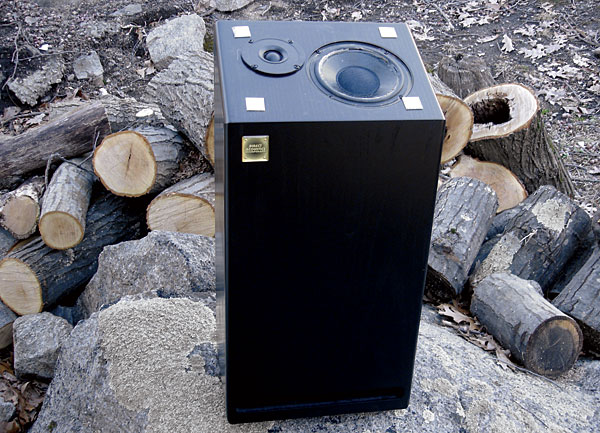
Lot's more variations in that thread.
Perhaps the thread might be an entertaining read for you, as it's mainly about up firing speakers like the "Silent Speaker": http://www.diyaudio.com/forums/multi-way/121385-advantages-floor-coupled-up-firing-speakers-180.html#post3355294

Lot's more variations in that thread.
I'd look up the works of Allison, both his speakers and his papers.
It's not that complicated until you add the TL effects, but as for the angled upward firing, um, just say no. It reminds me a lot of some of the M&K surround speakers. Meh, if they were that good they would have taken off.
You can create a good wall placed loudspeaker, the trick is properly measuring and adjusting for the support the rear wall will give you, and picking a suitable narrow dispersion tweeter, that will minimize side wall reflections.
Of course, a more simple option is to create great, small monitors and use an invisible sub.
Best,
Erik
It's not that complicated until you add the TL effects, but as for the angled upward firing, um, just say no. It reminds me a lot of some of the M&K surround speakers. Meh, if they were that good they would have taken off.
You can create a good wall placed loudspeaker, the trick is properly measuring and adjusting for the support the rear wall will give you, and picking a suitable narrow dispersion tweeter, that will minimize side wall reflections.
Of course, a more simple option is to create great, small monitors and use an invisible sub.
Best,
Erik
...I personally love the look of these speakers
but my wife claim that they “take over the room”.
Her wish list is for something small that
“blend with the walls” (white by the way).
Think about in-ceiling and in-wall speakers.
Attachments
Thanks for your replies.
 Might be a bit easier to guess how it's designed compared to the Silent Speaker but I would prefer the shallower depth and forward facing port of the Silent Speaker.
Might be a bit easier to guess how it's designed compared to the Silent Speaker but I would prefer the shallower depth and forward facing port of the Silent Speaker.


I actually read through that thread a week ago and noticed the Enigma by Heed Audio. Another nice looking contender for my next DIY projectI was pretty sure I had seen those speakers before on this forum...
Will do...I'd look up the works of Allison, both his speakers and his papers.
My head agrees 100% but my hart screams for a upward firing T-Line/MLTL build... but as for the angled upward firing, um, just say no.
I know but I don't fancy subs (the one I got is in the garage)...Of course, a more simple option is to create great, small monitors and use an invisible sub.
No way! What I love is the look of the SoundSpan and I rather part with them than cover them upthrow a sheet over your current speakers ??????
Great suggestion but it will not happen. I once fell for the surround setup and ended up with more than 70 meters of cables routed through our living room. My wife was not allowed to move the sofa out of the sweet spot for more than 5 years. I learned that I prefer a classic stereo setup and the value of separates that can be easily swapped in and out. If I will try anything new it would be active XO and biamp. Maybe a bit overkill for a 2-way system, or?Think about in-ceiling and in-wall speakers.
Last edited:
and picking a suitable narrow dispersion tweeter,
that will minimize side wall reflections.
Erik
Hi,
No, that won't help at all, it will give very poor direct sound.
The TL stuff is a smokescreen that basically won't affect
the overall sound of such an arrangement, which is bound
to be flawed somewhat, given the layout, placement, angle.
IMO you have to accept this is all about trying to make the
best of a bad job, and keeping it as simple as possible.
The Silent looks a good basis. Not too tall, wider than
it is deep to placed on the floor up against a wall. I
suggest more angle than 22 degrees, as said 30.
For the bass mid I suggested vented is the best option.
Its tested here : Zaph|Audio
It would work well in a 40L box tuned to 35Hz.
The x/o requires some guesswork due to the unusual situation,
its quite possible the Silent arrangement will work better than
my earlier suggested arrangement, but who knows ?
(Bassmid no x/o, tweeter 2nd order + l-pad to suit.)
rgds, sreten.
Last edited:
That would bring them more in line with the Heed Enigma. Makes you consider their driver arrangement too but it would make it narrower and deeper......
The Silent looks a good basis. Not too tall, wider than
it is deep to placed on the floor up against a wall. I
suggest more angle than 22 degrees, as said 30.
I had a look at it, doesn't it have quite a low Qts fo a T-Line? I was considering the CA18RLY based on it's higher Qts (but I will eventually model both and check the difference). Maybe a MLTL requires less Qts than a classic T-Line? MLTL seems quite close to a traditional ported box...For the bass mid I suggested vented is the best option.
Its tested here : Zaph|Audio
It would work well in a 40L box tuned to 35Hz.
I am reading up on MLTL and found the following page interesting. If it's correct then the size of the Silent Speaker and Heed Enigma makes much more sense.
Take the classic T-Line length for lets say 40Hz (340/(4*40) = 2.125m) and multiply it with 0.6 -> 1275cm. Now fold the line in half and you get ~ 64cm. Subtract the bend and you end up with two vertical lines of ~ 55 cm each. Seems close enough when I look at the Silent Speaker.
It seems like the Silent Speaker uses a decreasing taper (based on the reviews note about an inverted horn design). The slot port could then be just a terminus, much like in my picture B. I guess it could be configured the other way around with an expanding taper and more of a real port, like in my picture C. I don't know whats better but I might try and model both based on the principles found on the What's an ML-TL? page...
Any more suggestions for drivers given a MLTL design and a slanted baffle of 22-30 degrees?
I am reading up on MLTL and found the following page interesting.
Reading the 1st section this is clearly a retelling of the work Martin King has done. The place to start when wants to learn about modern TLs is MJK's site: Quarter Wavelength Loudspeaker Design.
Our understanding of, and the capability to design, TLs improved dramatically with the work of King & Augspurger in 1999. Augspurger did not take it further, King has been refining his work since then.
The Silent Speaker is a Wilmslow Burhoe design so is his continuation of EPI, Genesis, more...
dave
I also found this here (seems to support much, if not all, of what was stated at the What's an ML-TL? page):
...
The most important of the design parameters is the design of the cabinet:
Length and geometry to set the tuning frequency -- Tuning frequency is set by the length of the line and the geometry.
For a straight line, it is simply a quarter wave of the frequency.
A tapered line (opening has a smaller area than the closed end of the pipe) is the smallest possible enclosure for the same frequency. A tapered line is very good at taming the unwanted upper harmonics. The output from the opening is broader and with slightly less output, compared to the straight line.
An expanding line will be the longest line for the same tuning frequency. It has a high output level, unfortunately the frequency curve is very uneven.
If you mass load the straight line, by making the area of the opening smaller than the cross section, the line will be shorter than the straight line for the same tuning frequency.
A larger volume will, in general, increase the bass and also lower the tuning frequency a bit.
Driver offset -- In a straight TL, moving the driver down approximately one third of the line will eliminate half the peaks in the higher harmonics. This is a very useful, old trick to tame the frequency response. The cost is slightly less bass.
Stuffing to dampen nulls, ripples and impedance peaks -- The last option is stuffing, which should be relatively light so as not to attenuate the opening output too much. Stuffing will make the frequency curve smoother and dampen impedance peaks. The draw back is less bass.
...
...
The most important of the design parameters is the design of the cabinet:
Length and geometry to set the tuning frequency -- Tuning frequency is set by the length of the line and the geometry.
For a straight line, it is simply a quarter wave of the frequency.
A tapered line (opening has a smaller area than the closed end of the pipe) is the smallest possible enclosure for the same frequency. A tapered line is very good at taming the unwanted upper harmonics. The output from the opening is broader and with slightly less output, compared to the straight line.
An expanding line will be the longest line for the same tuning frequency. It has a high output level, unfortunately the frequency curve is very uneven.
If you mass load the straight line, by making the area of the opening smaller than the cross section, the line will be shorter than the straight line for the same tuning frequency.
A larger volume will, in general, increase the bass and also lower the tuning frequency a bit.
Driver offset -- In a straight TL, moving the driver down approximately one third of the line will eliminate half the peaks in the higher harmonics. This is a very useful, old trick to tame the frequency response. The cost is slightly less bass.
Stuffing to dampen nulls, ripples and impedance peaks -- The last option is stuffing, which should be relatively light so as not to attenuate the opening output too much. Stuffing will make the frequency curve smoother and dampen impedance peaks. The draw back is less bass.
...
http://www.t-linespeakers.org/design/MJK-for-dummies/index.html
That is my site, an article by the fellow that designed Tabaq. The site has been around since before MJK and before Martin put his own site together i hosted his work.
dave
Driver offset -- In a straight TL, moving the driver down approximately one third of the line will eliminate half the peaks in the higher harmonics.
In any TL, it doesn't have to be straight.
dave
Thanks Dave for summing it all up on your site. It all starts to make sense now!That is my site, an article by the fellow that designed Tabaq. The site has been around since before MJK and before Martin put his own site together i hosted his work.
It seems like a tapered non expanding line (like my picture B) is preferable given the height of the enclosure and therefor constraint on the line length. I also guess that a Qts > 0.35 would be a good thing. Let's use the SEAS H1217-08 CA18RLY as an example to illustrate how low this could get. Qts > 0.35 -> tune the enclosure 5-10 Hz lower than the driver Fs, right? That would be ~ 35 Hz. 340/(4*35) = 243 cm, times 0.6 -> 146 cm line length. A cross section of 2-3 times Sd and a 1:10 taper would split the base in ~ 13 and 4 cm (countered for an internal baffle of 19mm (3/4") thickness). That gives us cross sections of 390 cm2 at the wide (closed) end and 120 cm2 at the narrow (open) end. It also makes the thin slot port of 30*3 cm (90 cm2) act as a mass loading port, right?
I'm not sure this speaker needs to be tunes as low as 35Hz so maybe something with a lower Qts like the suggested P18RNX/P could work. Qts < 0.35 so tune the enclosure 5-10 Hz above the driver's Fs, right? Lets say 50Hz, 340/(4*50) = 170 cm, times 0.6 -> 102 cm line length. I can use Qts and Fs of the driver to adjust the height of the enclosure. Keeping up Qts and Volume of enclosure if I prioritize low bass, right?
The Silent Speaker is making more and more sense
Last edited:
Regarding fS and Qts and the optimum tuning frequency, regardless of the specific TL configuration, if the desired overall response shape is nominally flat from the knee in the response curve on up, when Qts is close or equal to 0.4, the tuning frequency should be close or equal to fS. If Qts is lower than 0.4, the tuning frequency needs to be higher than fS, and if Qts is higher than 0.4, the tuning frequency needs to be lower than fS. The exact amount to tune above or below fS can only be determined accurately via modeling, and using manufacturers' published driver specs isn't always a good idea. BTW, the link you provided to "What's an ML-TL" I wrote for Dennis Murphy and the TLs I designed he uses in his Philharmonic Audio speakers.
Paul
Paul
Thanks Dave for summing it all up on your site. It all starts to make sense now!
It seems like a tapered non expanding line (like my picture B) is preferable given the height of the enclosure and therefor constraint on the line length. I also guess that a Qts > 0.35 would be a good thing. Let's use the SEAS H1217-08 CA18RLY as an example to illustrate how low this could get. Qts > 0.35 -> tune the enclosure 5-10 Hz lower than the driver Fs, right? That would be ~ 35 Hz. 340/(4*35) = 243 cm, times 0.6 -> 146 cm line length. A cross section of 2-3 times Sd and a 1:10 taper would split the base in ~ 13 and 4 cm (countered for an internal baffle of 19mm (3/4") thickness). That gives us cross sections of 390 cm2 at the wide (closed) end and 120 cm2 at the narrow (open) end. It also makes the thin slot port of 30*3 cm (90 cm2) act as a mass loading port, right?
I'm not sure this speaker needs to be tunes as low as 35Hz so maybe something with a lower Qts like the suggested P18RNX/P could work. Qts < 0.35 so tune the enclosure 5-10 Hz above the driver's Fs, right? Lets say 50Hz, 340/(4*50) = 170 cm, times 0.6 -> 102 cm line length. I can use Qts and Fs of the driver to adjust the height of the enclosure. Keeping up Qts and Volume of enclosure if I prioritize low bass, right?
The Silent Speaker is making more and more sense
Last edited:
- Status
- This old topic is closed. If you want to reopen this topic, contact a moderator using the "Report Post" button.
- Home
- Loudspeakers
- Multi-Way
- Help figuring out the Silent Speaker
